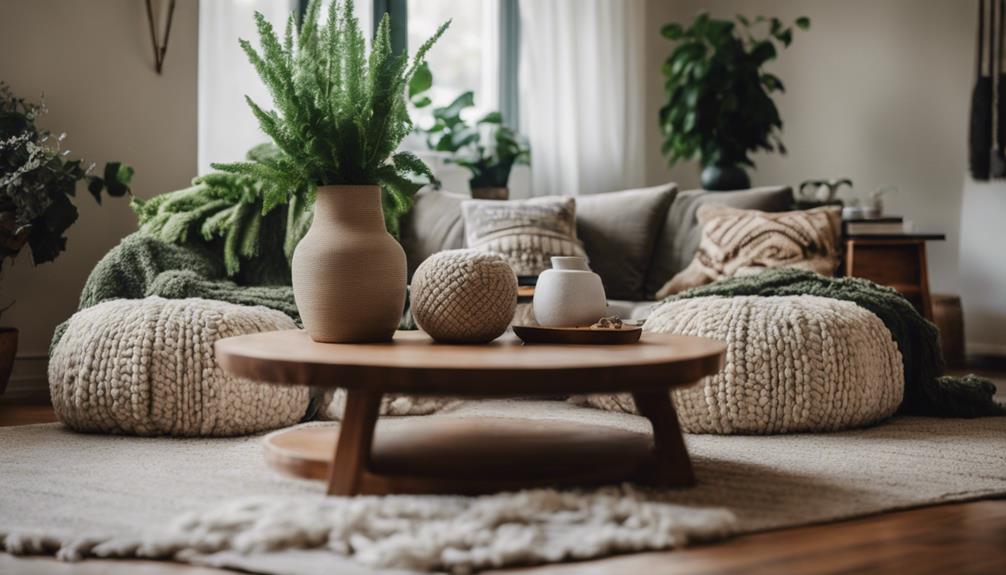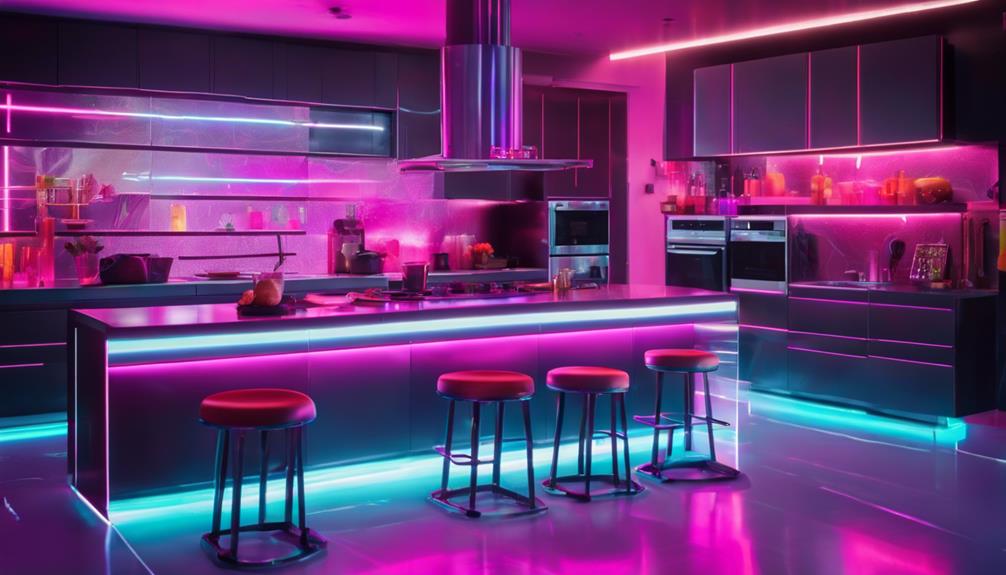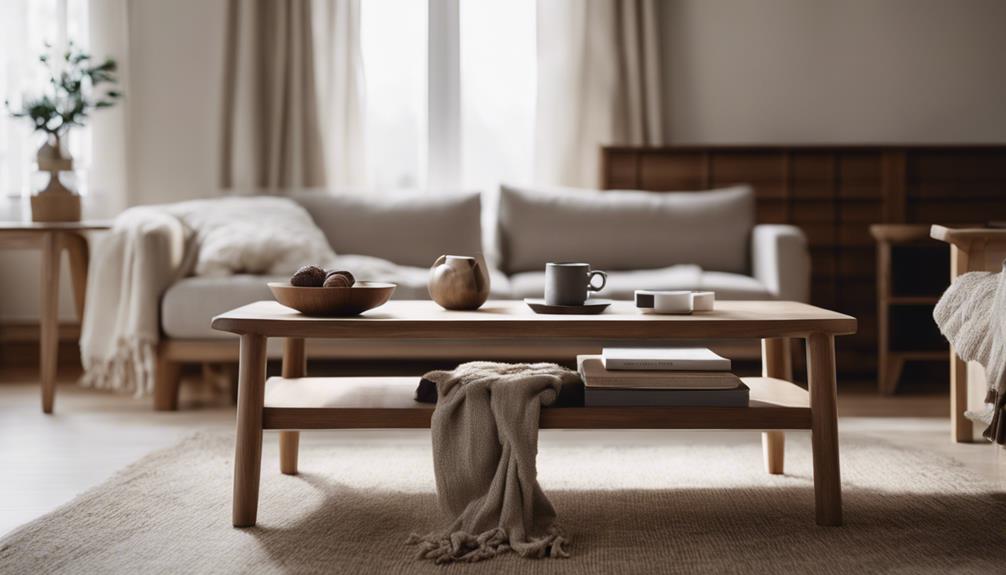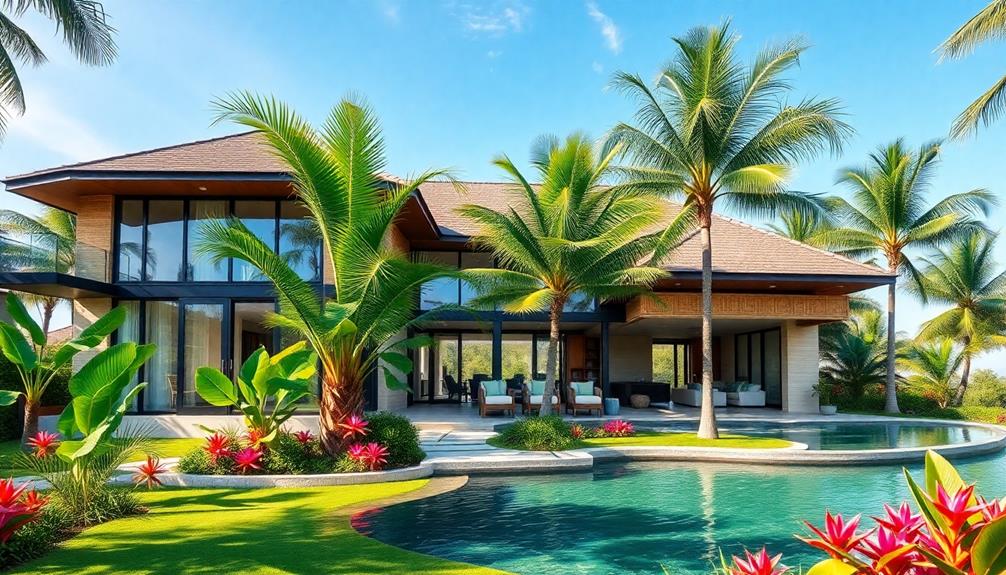To add depth and interest in any room, focus on layering textures. Mix plush rugs with sleek leather, or balance soft and rough surfaces to enhance visual appeal. Incorporate natural materials like wood and stone for warmth and character. Accent with textured pillows or textured walls as striking focal points. Keep a cohesive color palette to unify your design while mixing various textiles. This not only prevents your space from feeling flat but also creates a cozy atmosphere. With these tips, you'll create a dynamic environment that resonates. Discover even more ways to transform your space seamlessly.
Key Takeaways
- Layer different textiles, such as plush rugs and smooth leather, to create warmth and visual complexity in your space.
- Incorporate natural elements like wood and stone to add character, depth, and a connection to the outdoors.
- Use textured wall treatments, like exposed brick or patterned wallpaper, to establish striking focal points that elevate the room's ambiance.
- Mix contrasting materials, such as soft fabrics and hard surfaces, to enhance visual interest and maintain a harmonious atmosphere.
Why Texture Matters
Understanding why texture matters can transform your space from ordinary to extraordinary, adding depth and inviting warmth that keeps you engaged.
In interior design, textures play a vital role in enhancing visual interest and preventing your space from feeling flat or uninviting. By thoughtfully incorporating various materials, you can evoke distinct emotional responses, creating a sensory experience that resonates with you and your guests.
Layering different textures adds complexity and richness to your environment, encouraging exploration and enhancing beauty. Whether it's combining soft fabrics with sleek surfaces or mixing rustic woods with polished metals, these choices create a dynamic balance that captivates the eye.
When done correctly, textures unify your color schemes, establishing a cohesive aesthetic that feels harmonious and intentional.
However, misjudged texture choices can lead to a disjointed appearance, disrupting the flow of your room. That's why it's important to reflect on how different materials interact with each other.
Understanding Texture
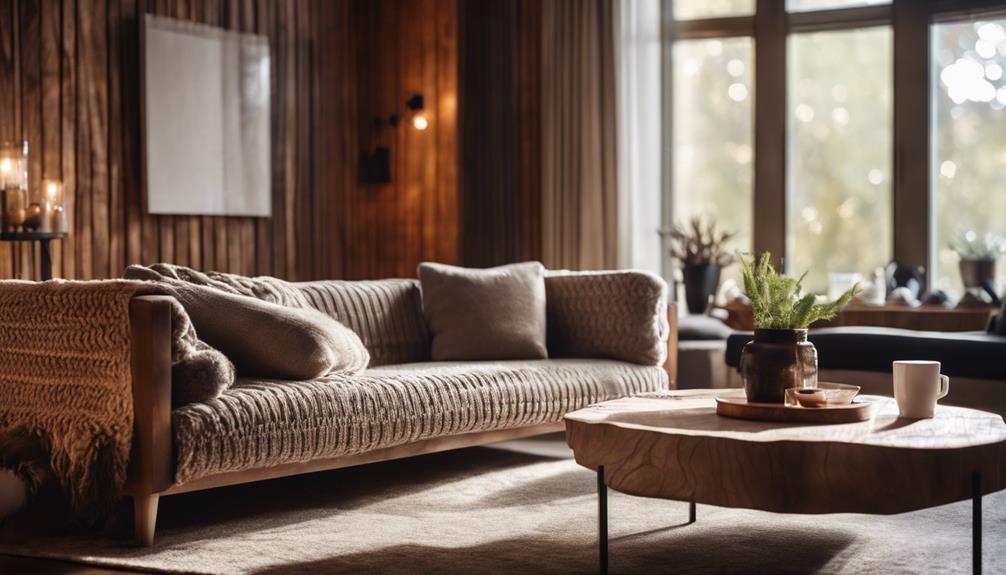
When you think about texture in your home, consider how it can evoke emotions and create connections.
Layering different textures not only adds visual interest but also invites touch, making your space feel more dynamic.
Emotional Impact of Textures
Textures profoundly shape your emotional experience in a space, influencing how you feel and interact with your surroundings. By carefully selecting and layering different textures, you can create an inviting atmosphere that evokes rich emotional responses.
Consider how various textures impact your mood:
- Soft fabrics create coziness and relaxation.
- Rough surfaces offer stability and earthiness.
When you incorporate these elements, you add depth and visual interest to your environment. Textures not only enhance the overall aesthetic but also contribute to a multisensory environment, allowing you to imagine tactile experiences without direct interaction.
This exploration of textures fosters a deeper connection to your space, making it more engaging and dynamic.
Visual Engagement Through Layering
Layering different textures in your home can transform a bland space into a visually engaging environment that invites curiosity and warmth. By adding depth and visual interest, you create a room that feels alive and welcoming.
Start by combining various textures like plush rugs and smooth leather, which enhance the overall aesthetic and create depth and dimension. Consider using different materials and finishes, such as rough wood accents alongside soft, textured textiles. This contrast not only captivates the eye but also establishes a warm and inviting atmosphere.
Think about layering through textiles, like mixing linen curtains with velvet throw pillows, to introduce complexity and richness into your design. Effective layering hinges on carefully selecting textures that harmonize while maintaining a balance between contrasting elements.
Analyze how these textures interact, and you'll achieve a visually interesting effect that engages the senses. With thoughtful layering, your space can become a sensory experience, encouraging exploration and comfort.
Embrace the art of layering textures, and watch your interiors transform into stunning, multidimensional spaces that reflect your unique style.
Techniques for Layering
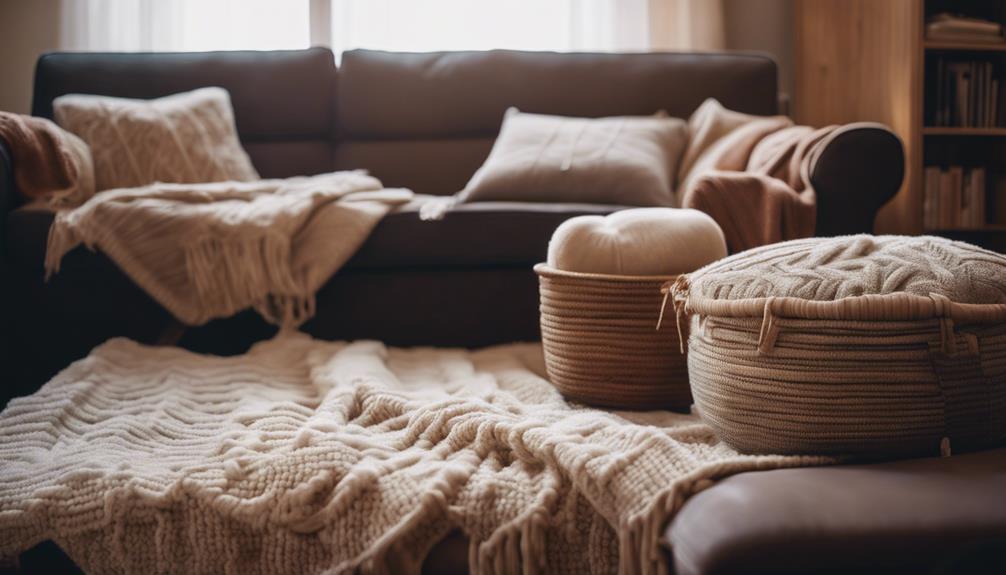
Combining different materials, like soft fabrics with hard surfaces, creates visual interest and depth in your home decor. Layering textures effectively can transform any space into a cozy and inviting atmosphere. Here are some techniques to help you achieve that:
- Mixing textiles: Pair plush rugs with smooth leather furniture to enhance warmth and comfort.
- Incorporating various textures: Use curtains, throw pillows, and area rugs to create a rich tapestry of textures.
When you layer textures, it's essential to maintain a cohesive color palette. This guarantees that the different materials you choose complement each other rather than compete for attention.
For instance, if you decide on earthy tones for your plush rugs, consider matching it with a similarly toned smooth leather sofa for a unified look.
By taking these steps, you'll add depth and dimension to your decor, making your space feel more dynamic and inviting.
Embrace the art of layering textures, and watch your home transform into a stylish sanctuary!
Natural and Organic Textures
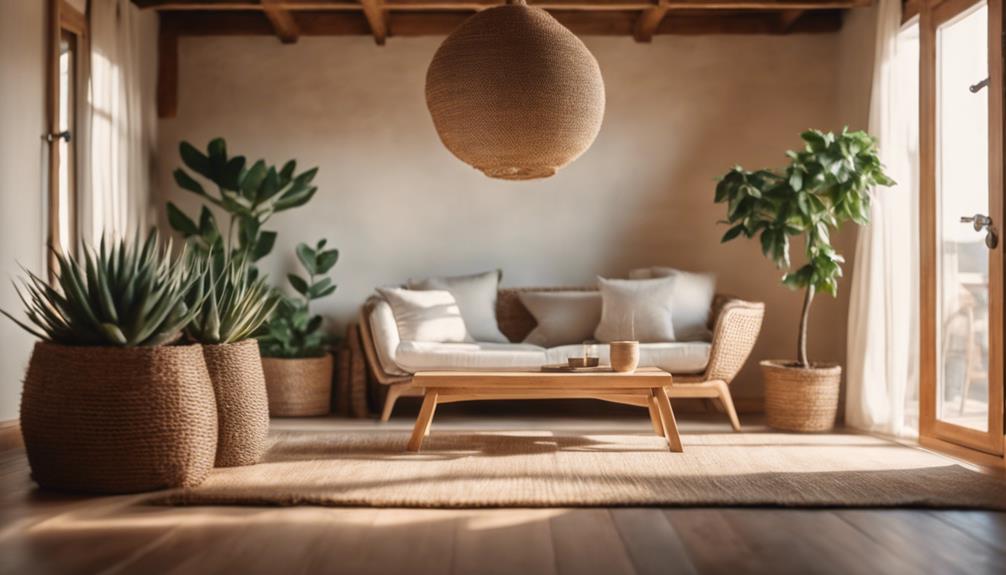
When you choose natural and organic textures, you're bringing warmth and authenticity into your space.
Materials like wood, jute, and stone not only enhance aesthetics but also promote a connection to nature that can boost your well-being.
Benefits of Organic Materials
Using organic materials like wood and rattan not only brings a warm, earthy vibe to your home but also helps create a serene environment that enhances your well-being. By incorporating these natural textures, you can transform your space into an inviting haven.
- Promotes Relaxation: Organic materials foster a connection to the outdoors, enhancing your sense of calm and comfort.
- Adds Character: The unique qualities of natural fibers introduce varying textures, creating visual interest that enriches your room's aesthetic.
When you choose organic materials for furniture, flooring, and decor, you're not just decorating; you're cultivating authentic spaces that resonate with warmth and comfort.
These choices reflect your commitment to eco-friendly practices, making your home feel more meaningful. Plus, the depth and complexity of natural textures can elevate your design, making it both beautiful and functional.
Embrace the benefits of organic materials, and watch your surroundings transform into serene, inviting environments you'll love to come home to.
Incorporating Natural Elements
Incorporating natural elements like wood, stone, and rattan instantly brings warmth and character to your home, creating a soothing atmosphere that nurtures your well-being. By thoughtfully integrating organic materials, you establish a seamless connection between your indoor spaces and the natural world.
| Natural Element | Benefits |
|---|---|
| Wood | Adds warmth and character, especially when using reclaimed wood. |
| Stone | Provides durability and a unique aesthetic with its natural patterns. |
| Rattan | Offers a lightweight, breathable texture that enhances comfort. |
| Bamboo | A sustainable option with a sleek look, perfect for modern decor. |
| Natural Fibers | Introduces tactile variety through rugs and textiles, like jute or wool. |
Emphasizing sustainability while incorporating natural textures can greatly enhance your decor. Each piece you choose adds depth and interest, showcasing unique patterns and imperfections that tell a story. By embracing these elements, you'll not only beautify your living space but also create a more inviting and harmonious environment.
Warmth and Authenticity
Natural and organic textures instantly infuse your space with warmth and authenticity, creating a welcoming atmosphere that feels both grounded and inviting. By using natural materials like wood, jute, rattan, and bamboo, you bring an earthy feel to your interiors. This not only enhances aesthetic appeal but also fosters a connection with the outdoors, promoting a calming ambiance.
Here are three key benefits of incorporating organic textures:
- Enhanced Character: Natural textures add unique character and depth to your space, making it visually engaging.
- Cozy Atmosphere: Elements like stone and organic fibers help establish a cozy atmosphere, transforming your home into inviting spaces.
Integrating these textures into your furniture, flooring, and wall coverings creates a multi-dimensional experience that engages the senses. You'll find that using organic textures makes your home feel lived-in and warm, ensuring every corner exudes authenticity.
Statement Textured Walls
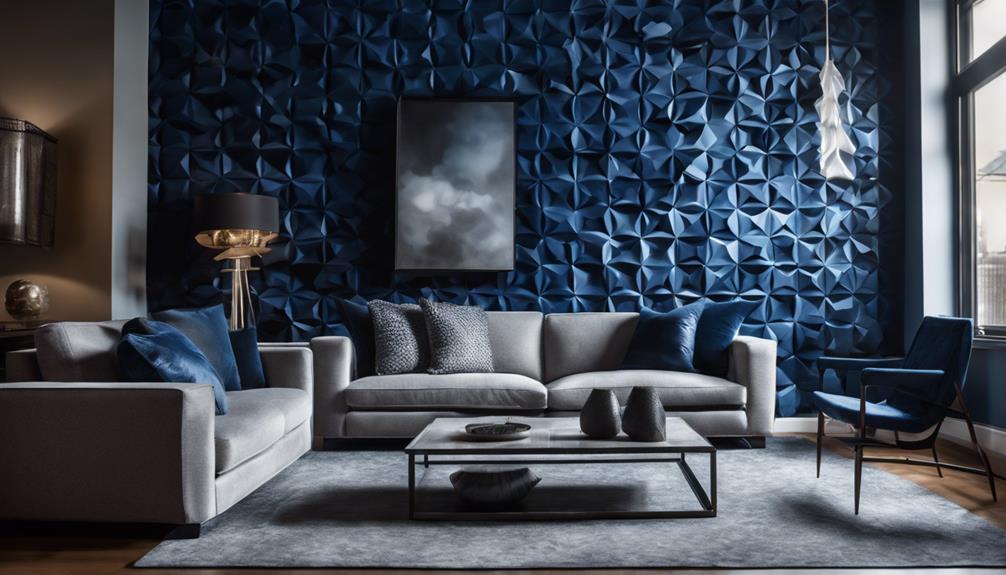
Statement textured walls create a striking focal point in any room, instantly elevating the space's ambiance and style. Incorporating these statement textured walls adds visual interest and depth, making your interiors come alive. Whether you choose exposed brick, patterned wallpaper, or textured finishes, each option brings a unique ambiance that transforms your environment.
Exposed brick can evoke a rustic charm, while patterned wallpaper can introduce playful patterns and colors that enhance your room's aesthetic appeal. Textured finishes, on the other hand, can create a sleek and modern look, giving your walls a sophisticated edge. Whichever choice you make, textured walls serve as a backdrop that breathes life into your space, creating a warm and inviting atmosphere.
Additionally, statement textured walls can complement other design elements, allowing for a harmonious look throughout the room. This balance not only enhances the overall mood of the space but also guarantees that your home feels cohesive and thoughtfully designed.
Mixing and Matching Materials
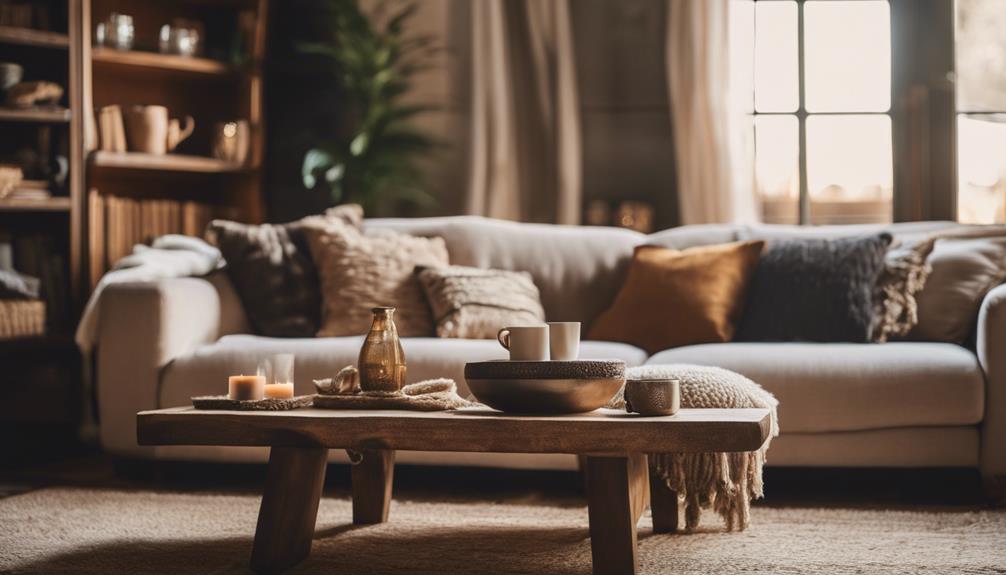
Mixing materials like wood, metal, and fabric can dramatically enhance your room's aesthetic by creating visual contrast and inviting diverse textures. By thoughtfully layering different materials, you can create depth and add visual interest to your space.
Here are a few tips to guide your mixing and matching:
- Combine smooth and rough: Pair polished surfaces like glass with rustic reclaimed wood.
- Use a variety of fabrics: Incorporate unique textures like velvet, linen, and cotton to foster a cozy atmosphere.
When you embrace contrasting elements, you not only enhance aesthetics but also transform a room into a curated, intentional environment. Each material contributes to the overall narrative, creating a space that feels both inviting and sophisticated.
Whether you're adding texture through textiles or balancing warm and cool tones, remember that the key to successful mixing lies in harmony. So go ahead—experiment with different materials and watch your space come alive!
Practical Application Tips
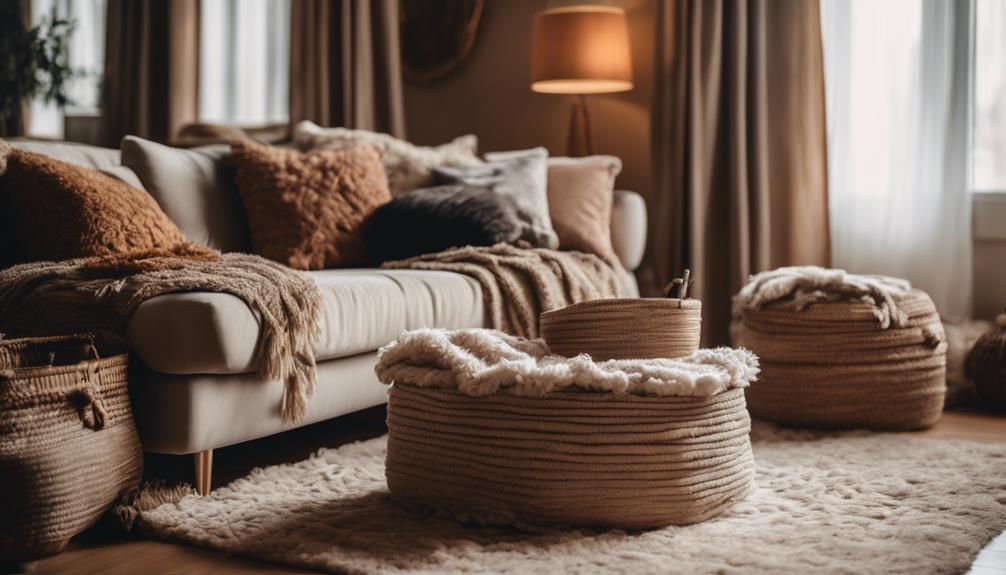
To effectively elevate your home decor, apply practical techniques that enhance the textures you've already curated through mixing materials.
Start by incorporating different textures in interior design, like layering different rugs. A plush area rug over a jute base adds depth and warmth to your floors while creating a tactile experience.
Next, use accent pieces to introduce visual interest. Throw pillows and blankets in unique textures, such as velvet and boucle, bring softness and comfort to harder surfaces. These elements soften visual weight and invite relaxation.
Consider textured wall treatments like shiplap or exposed brick. They serve as impactful focal points, drawing the eye and adding character to your space.
Additionally, mixing natural elements, like plants or wood furniture, with man-made textures establishes a warm atmosphere that enhances the overall design. This balance promotes a welcoming vibe while adding dimension to a room.
Creating Visual Balance
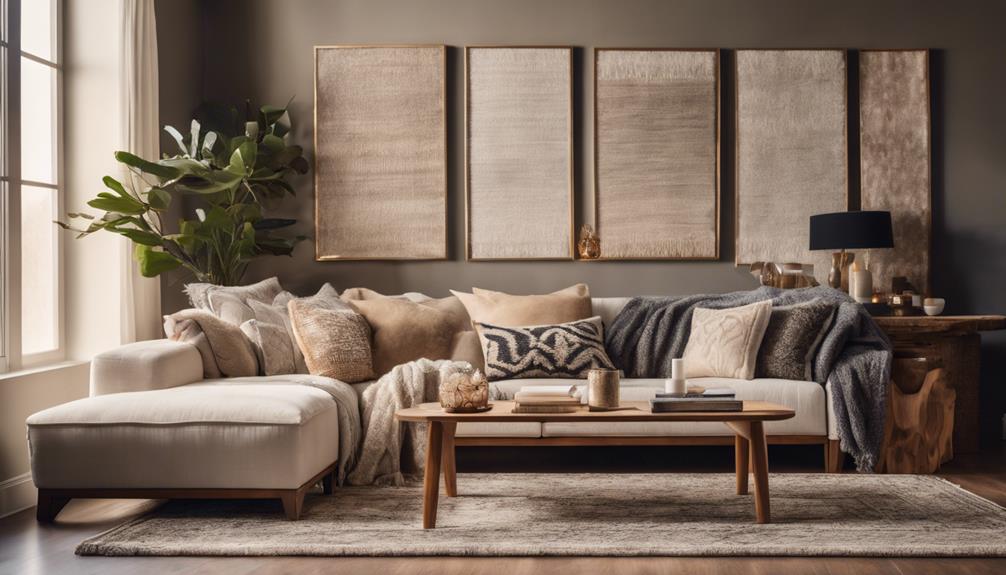
Achieving visual balance in your space involves thoughtfully distributing a variety of textures to create a harmonious and inviting atmosphere. By combining different textures, you can add depth and visual interest without overwhelming the room.
Interior designers often recommend a careful layering of textures to enhance room perception. Here are some tips to help you achieve visual balance:
- Mix hard and soft textures, like sleek metal tables with plush velvet chairs.
- Use natural materials, such as wood and rattan, alongside synthetic options for contrast.
When creating depth and visual appeal, consider the visual weight of each texture. Heavier materials, like stone, should be balanced with lighter textiles to maintain equilibrium.
This contrast not only draws attention to specific design elements but also creates a comfortable environment. By thoughtfully incorporating these strategies, you can transform any room into a well-balanced, inviting space that reflects your personal style while ensuring that visual balance is maintained throughout.
How Can I Use Y2K Room Decor to Add Texture and Interest to My Space?
Looking to give your space a unique and nostalgic touch? Consider incorporating y2k room decor ideas into your design. Add throwback elements like beaded curtains, shag rugs, and metallic accents to infuse your space with texture and visual interest. Embrace the vibe of the early 2000s to elevate your room decor.
Conclusion
Incorporating texture can truly transform your space, adding depth and interest that draws the eye.
Remember, just like a vinyl record, each layer contributes to the overall harmony of your room.
By mixing materials and creating visual balance, you'll turn any ordinary area into an enchanting experience.
So go ahead, get creative!
Embrace the power of texture, and watch your home come alive with personality and style.
Your sanctuary deserves nothing less!
